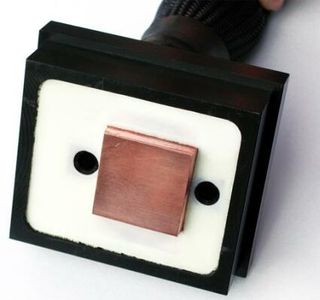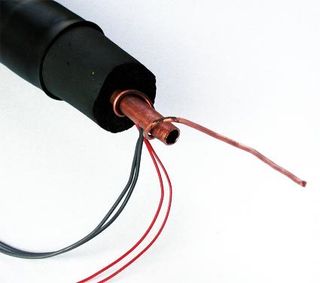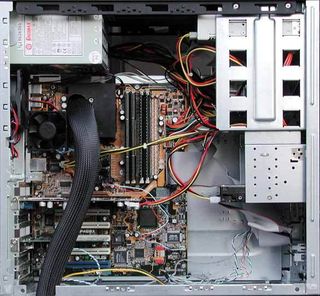The Iceman Cometh: P4 at 4.1 GHz
Room Heater: P4 With 135 W Power Dissipation

Compressor system cooling head for connecting to the CPU socket: at full power, the temperature is minus 52 degrees Celsius.
Intel's current top model, the 3.06 GHz Pentium 4, has a maximum power dissipation of 85 W. It takes the top spot in this regard in the world of x86 even in front of the AMD Athlon XP 2800+. To remove this heat and transfer it into the environment, a powerful cooler is needed. Since the temperature of the CPU die rises markedly with extreme overclocking, ensuring efficient heat transmission is not enough; we need active cooling. Fan-cooling alone is not an option. Neither is water-cooling, as it cannot cool below room temperature (although we are keen on its low noise levels). For our tests we employed a compressor cooler from Chip Con , which cools the CPU to well below zero degrees Celsius. This cooling system is worlds apart from even a top-ranking water cooler. With our modifications, the CPU cooler cools down to a temperature of minus 52 degrees Celsius.

This copper pipe contains R134a coolant, which has a boiling point of approximately 60 degrees Celsius under vacuum.

View of the cooling head for the P4.
With an average CPU power dissipation of 107 W, the Prometeia from Chip Con will normally maintain a temperature of minus 28 degrees Celsius. This increases the power dissipation when overclocking the P4 from 85 W to an enormous 135 W. This represents a rise of 63 percent. This power consumption is extremely stressful for the voltage regulators. In our first test with the Asus P4G8X, which is fitted with a two-phase regulator, the components overheated so much that they shifted on the board. An efficient ventilation system prevents the solder from melting. Remember, we are dealing here with an overclocked CPU drawing 78.3 amps through four voltage regulators.

Test system for the record attempt: 3.06 GHz P4 and the Chip Con compressor cooler.
Stay on the Cutting Edge
Join the experts who read Tom's Hardware for the inside track on enthusiast PC tech news — and have for over 25 years. We'll send breaking news and in-depth reviews of CPUs, GPUs, AI, maker hardware and more straight to your inbox.
Current page: Room Heater: P4 With 135 W Power Dissipation
Prev Page Maximum Clock Speed: The Right CPU Makes All The Difference Next Page New, Boxed Cooler For The P4 From 3.06 GHz UpMost Popular

